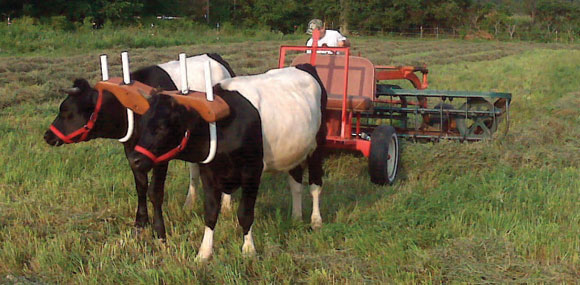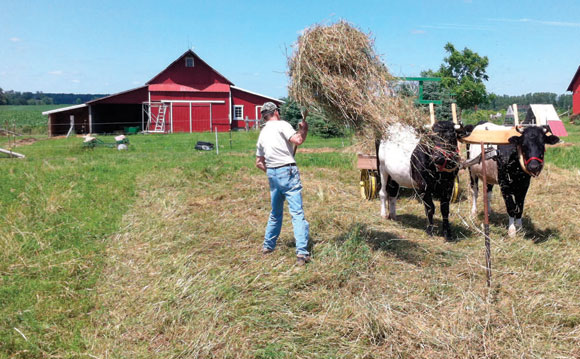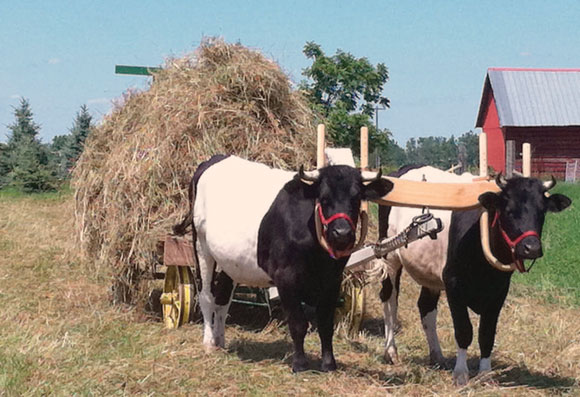Oxen-Powered Haymaking

Sound too good to be true? Let me first address the caveats to the system:
- The pasture is 4th year, excellent quality alfalfa/ orchardgrass, so it yields better than many other plots of similar size.
- 2011 was a good year for haymaking in Southwest Michigan, with plentiful rains punctuated by periods of fair skies.
- I made use of free "supplemental feeds" whenever possible. More on that later
- I made a conscious choice to avoid fossil fuels whenever practical and to enjoy the process. If working with the animals daily is drudgery to you, please turn the page and move on. Since you're reading this magazine, I'll assume that's not an issue.
To get started, and to see the context of where a system like this can work, I own three and a half acres in total of yard, seven outbuildings, gardens and pasture. Of that, the cattle get about half, with a barnyard making up a quarter to a half acre. That leaves around one and a quarter to one and a half acres for intensive grazing, surrounded by high tensile electric fence.
At the beginning of the grazing season, I began using temporary wires and step-in posts to move the cattle around the pasture, starting with the perimeter, my thinking being that the edges were grassier than the middle, relative to the amount of alfalfa, thus reducing the chance of bloat, and that the animals could help control undergrowth on the fence line.
At that point, they were getting some hay in the morning and then I'd move the fence in the afternoon, again to try to avoid bloat, and to get the pasture established. As the summer progressed, they stopped receiving hay, and the fence was moved daily, typically with a pair of hotwires to provide a small alley for grazing.
By the end of May into June, they had eaten through about one-third of the pasture, and the first cutting of hay was ready on the other two thirds. My dad brought over his restored John Deere B and Number 5 sickle bar mower and laid it down, with our intention to bale it all. Next, I raked the hay using the oxen on a forecart and our New Idea "tractor" rake, and the hay was ready. That evening, the hay wasn't quite ready to bale, but rain was in the forecast for the next day. I enlisted my dad, and we forked a nice-sized load onto a hay wagon attached to the forecart. A few tight turns later, and it was parked in front of the barn.

At this point, I’d like to tell you about how easy it was, loading the hay
into the mow using the wonderful and efficient haytracks and hooks in the barn. I’d also like to tell you that my
wallet isn’t big enough to hold all my money, but both would be a total fabrication. Instead, we unloaded the wagon a fork
at a time handing it up into the mow where it was stacked. By trading off who is in the mow, a load can be stacked in the
mow in about 20-30 minutes and the work isn’t altogether unpleasant. Certainly it’s no worse than unloading bales, and for
my money, probably more enjoyable, in large part due to the quiet rhythm of the work and the relatively light weight of
each fork, compared to a bale.
The next day, with none of the anticipated rain, the baler was brought out, and the rest of the field was baled and stacked
inside as well. While the bales take up less room than loose hay, for my purposes, I’m in no danger of running out of space.
The loose hay is stacked in a pile in the haymow where it fills a large space, but by the next time we made hay, it settled
down to about half of the space.
Since then, the combination of grazing and cutting hay has resulted in three cuttings or grazings as of August 15, most
cuttings being about what will fit on two wagons, or a moderately paced evening of loading and unloading. Some areas have
even had a pair of cuttings and been grazed twice already.
Even with a good year of haymaking, with a small acreage it’s important to look for additional feed wherever practical. As
a supplement to the pasture, and in order to make feed dollars go farther, I also create temporary paddocks in my yard to
allow the cattle to graze grass. I use a single strand of hotwire for the oxen alone and a Gallagher reel fence for the
oxen and the beef steer. As long as they respect a hotwire and a tolerance exists for watching where you step on the way
to the chicken coop, the system helps to buy a few extra days between cuttings or grazings. Plus, it gets the lawn mowed
with the least effort…or fuel usage for that matter.
I also supplement their feed with mowed grass whenever possible, a tip I learned from Midwest Ox Drovers Member Vicki Solomon.
I have a neighbor who mows an acre-sized lot across the road, and, for the price of raking and loading the grass, I can have it.
The oxen are more than able to pull a haywagon around while I load grass for feed and garden mulch, and the owner appreciates
getting his yard raked. A possible avenue for the future would be to ask him to let it mature and then mow it with a hay mower
and put it up as hay. For now, it is a nice treat at the right price.
I also chopped and fed sweet corn from my garden when it was possible, taking the tops from stalks after they had tasseled out
and the ears were mature—an idea I read in Gene Logsdon’s Small Scale Grain Raising— along with whole stalks where the
corn had already been picked. The cattle loved this and, to my way of thinking, it sped up the composting process for the corn
stalks.
Finally, I discovered that if I made the daily paddocks too large, the cattle would stomp down more than their fair share of
alfalfa. If I clipped the paddocks that they had already grazed, I could re-feed the alfalfa from that paddock to the animals in
a confined setting as hay. On one occasion, I had too much waste after grazing in a paddock that measured 100 feet by 30 feet,
too small for a hayrake, but too big to let go. To remedy the problem, my dad’s Gravely walk-behind mower with a three-foot
sickle bar cutter made quick work of it. Raking by hand with a traditional wooden hay rake enabled me to pile the hay and feed
it immediately, saving again on feed costs.
For the small farmer with just a few head of livestock and oxen or horses to help power the operation, I see several advantages
to this system of mixed-power haymaking. The first big advantage is the limited capital investment in the system, which can be
scaled to the size of your operation and budget. Basically, you need some way to cut the hay, rake the hay and load the hay for
transport to a storage area.
For cutting, options range from a scythe to a small, walk-behind, sickle bar mower to a large sickle mower pulled by tractor
or animal power. Obviously, a large mower-conditioner would make quick work of most hay fields and would allow for quicker
drying. This is certainly beyond the scale described here, even though Tillers has demonstrated its effective use with a team
of oxen and a powered forecart.
Once the hay is down and drying, having a couple of options for raking makes sense. An old-style wooden hand rake is a tool
everyone should own, as they are surprisingly effective, especially in a mixed power setting. Beyond that, a ground drive hay
rake is effective, relatively simple to operate, and generally not prohibitively expensive in my area. Pulled by oxen, it will
make fast, pleasant work of turning over a field of drying hay. Even a young team of one-year-olds should be able to manage a
couple of acres.
Loading and storage presents an additional range of options, again depending on scale and tolerance for investment. Hay can
certainly be stored in the field in hayricks, but if you have a barn it would make sense to use it for storage. To get the
hay loaded from the field, options in our mixed-power system range from a sled or stoneboat to a hand-loaded wagon, to a
hayloader (still available in many locations if you keep an eye out) to a baler, again pulled by animals or tractor.
A second advantage of the mixedpower haying system is that it allows the small-scale oxen (or horse) owner to depend less on
an outside hay supplier. Knowing that at least some hay will be home grown allows a great deal of flexibility in when and where
to purchase hay. For instance, this year alone I have had the opportunity to buy good hay from $5 per bale down to $1.50 per
bale, depending on the time of the season. Savings like this could certainly make a low-capital system pay for itself rather
quickly.
Finally, the biggest advantage of a mixed-power haymaking system would have to be the time spent using your animals. Most
folks who grew up around farming have horror stories about haymaking. While it’s hard to discount their aversion to toiling
in a dusty barn for hours while an elevator spews bales like candies on the classic I Love Lucy episode, my experience
has been that, for small scale operations like the one I describe, the job remains an opportunity to do something meaningful
and enjoyable, while still getting the hay in the barn. Adjusting the scale of the operation down to human and animal powered
size allows for the camaraderie of family, friends and a quiet team working together on a summer evening. It brings out the
enjoyment of kids as they climb the hayrack and walk the load to pack it down. It allows for the chance to chat with folks
who may have never done this kind of work before— catching up while passing on a new skill. It creates the opportunity to work
up a sweat at a pace that feels comfortably hard while watching the haystack grow. These things are largely absent in our tasks
today. Small-scale haymaking is certainly a way to bring them back.

For a great DIY project see "A $100 Ox Cart"
This article appeared in the December 2011/January 2012 issue of Rural Heritage magazine.
